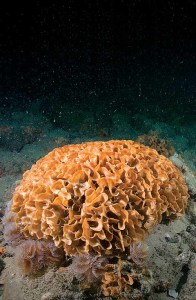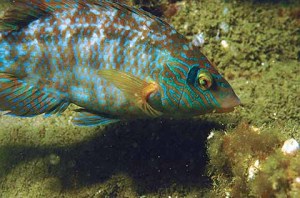What lies beneath
Sally Welbourne explores the shallow seas off the coast of Poole and Bournemouth
Published in September ’17
Underneath the waves, just one mile off the beach in Poole Bay, lies an underwater world the size of 600 football pitches which is bursting with colour, is rich with marine wildlife and has stories to tell which are every bit as interesting as the lives of our terrestrial wildlife living with us on dry land.
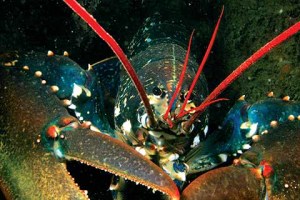
The European lobster can grow up to two feet long (60cm) and weigh up to nearly a stone (6kg)
Credit: Peter Tinsley
This little patch of marine life is known as Poole Rocks and was designated as a Marine Conservation Zone (MCZ) in 2013, in order to protect four square kilometres of seabed, ten different biological habitat types and 360 marine species. To most people this watery world just five minutes from Poole is less familiar than the Rift Valley or the Galapagos Islands.
Such is the growing concern for the disconnection from our marine environment that conservationists and other organisations have brought the colour and stories of local undersea existence to life with a new website just about this patch of rocks off Poole. It uses high-quality video and images to show the wildlife beneath the waves, which can be a challenge for marine conservationists, because helping us to appreciate the charm and charisma of a world we can’t see isn’t always straightforward.
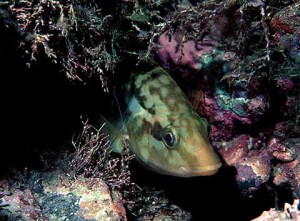
Ballan Wrasse are the biggest and most common of the wrasse family. They have powerful jaws and eat mussels, cockles, limpets, winkles and even hardback crabs and small lobsters
To the uninitiated, the brightly coloured lightbulb sea squirts, the unique and unmistakable shape of a Bloody Henry sea star, the stunning neon blue of the cuckoo wrasse and the bright red eyes of the velvet swimming crab gazing out from between the rocks are just seemingly random words: the majority of marine wildlife just doesn’t make an impact on most people’s consciousness in the way the larger mammals like dolphins, seals and whales do, but marine wildlife is just as rich and varied as its land-based counterpart, and often a bit weirder.
Poole Rocks was awarded MCZ protection due to the unique features of the site, such as the iron-rich rocky structures which create shelter and protection for species which would normally only be found in deeper water. These include the rare Couch’s goby, only recorded in a handful of sites in the UK, the Baillon’s wrasse, a rarity in the English Channel, and the once-common native oyster. The rocky reefs include pyrite formations jutting up from the seabed, containing ancient fossilised creatures and resembling a golden shipwreck. The reefs have different plants and animals living on the top, side, crevices and overhangs, and the mixed sediments (mud, sand, gravel) form a mosaic of habitats around the reefs, creating thriving breeding and hunting grounds. Nearby, there are ‘individual’ pink sea-fan coral, which is here at the easternmost edge of its range and which is legally protected under the Wildlife and Countryside 1981. Pink sea-fan is orange-pale pink in colour and made up of many anemone-type animals, feeding separately but living as a colony along a fan-like shape. This is a wonderful addition to the area, as we don’t always associate coral with UK waters.
One of the most interesting and special fish that returns each year to Poole Rocks MCZ is the black seabream. Each spring, thousands arrive in Poole Bay, transforming the seabed over hundreds of square metres. The males build large nests, which they fiercely protect, while the females spawn their eggs. The males have a full-time job guarding the nests for several weeks until the eggs hatch, warding off up to 40 different predators, including black gobies and goldsinny wrasse.
As we better understand the rarity and special features in the Poole Rocks MCZ, the need to protect these sites becomes clearer to us. However, the importance of this site has not been lost on divers and marine experts, who have been monitoring it since 1997. At only six to eleven metres deep, it is very accessible for divers, and for over twenty years, DWT has co-ordinated ‘Seasearch’, using hundreds of volunteer divers to scientifically map the seabed. In 2008, DWT worked in partnership with the Maritime and Coastguard Agency, Channel Coast Observatory, National Oceanographic Centre, Royal Navy and Viridor Credits on an ambitious project: the Dorset Integrated Seabed Study, or DORIS. This uses a range of remote acoustic surveying techniques, allowing conservationists to peel back the sea and to understand its undersea landscape in exquisite detail. It is thanks to the time and patience of local divers, conservationists and supporting organisations that we are able to see photos and video of ‘what lies beneath’, in the same way as we look at photos of wildflower meadows and birds.
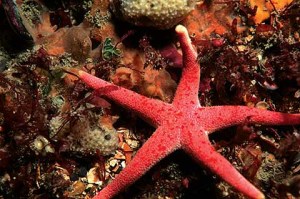
The Bloody Henry sea star is almost always found near sponges and coral because of the currents they create, making it easier for the sea star to filter feed
In fact, it is entirely possible to imagine Poole Rocks and all underwater spaces as another world, complete with habitats comparable with those on land, such as sea grass meadows, rocky reefs, kelp forests and sea bed caves. However, we are sometimes left feeling vulnerable from the vast expanse of it, the unknown wildlife we don’t recognise easily and the darkness which stretches out for miles when we open our eyes in the water. Humans may not be designed to live in it, but we are designed to be inquisitive and learn about our environment, so it is surely our responsibility to care for it for future generations by shining a light on it, taking an interest and learning from it,.
Marine Protected Areas (MPAs) are the umbrella term for any area in the sea which has recognition for its important features; MCZs are one type of MPA which were created under the Marine and Coastal Access Act 2009. In 2013, three MCZs were designated off the Dorset coast: Poole Rocks, Chesil & Stennis Ledges and South Dorset. These, along with others in the UK, are the first step to creating the 127 MCZ’s ultimately needed to create an ecologically coherent network of protection around the country.
The Poole Rocks MCZ website (http://poolerocksmcz.uk) is a partnership between Dorset Wildlife Trust, Southern Inshore Fisheries and Conservation Agency, the NEF (New Economics Foundation), Marine Conservation Society, Seasearch and Seven Tenths Ecology Ltd.
To find out more about the Dorset Intergrated Seabed Study visit
www.dorsetwildlifetrust.org.uk/doris.html
